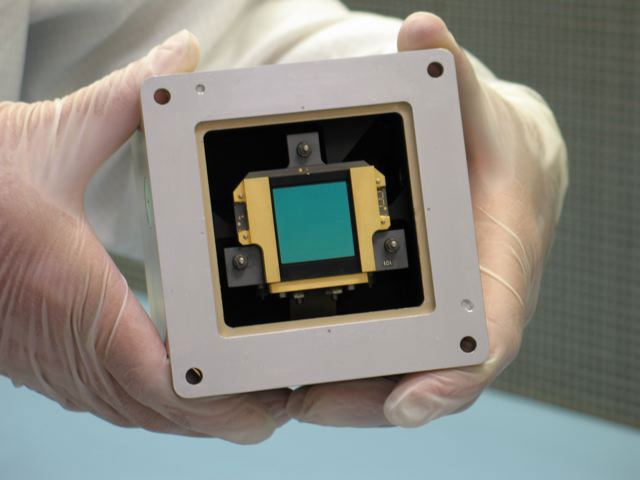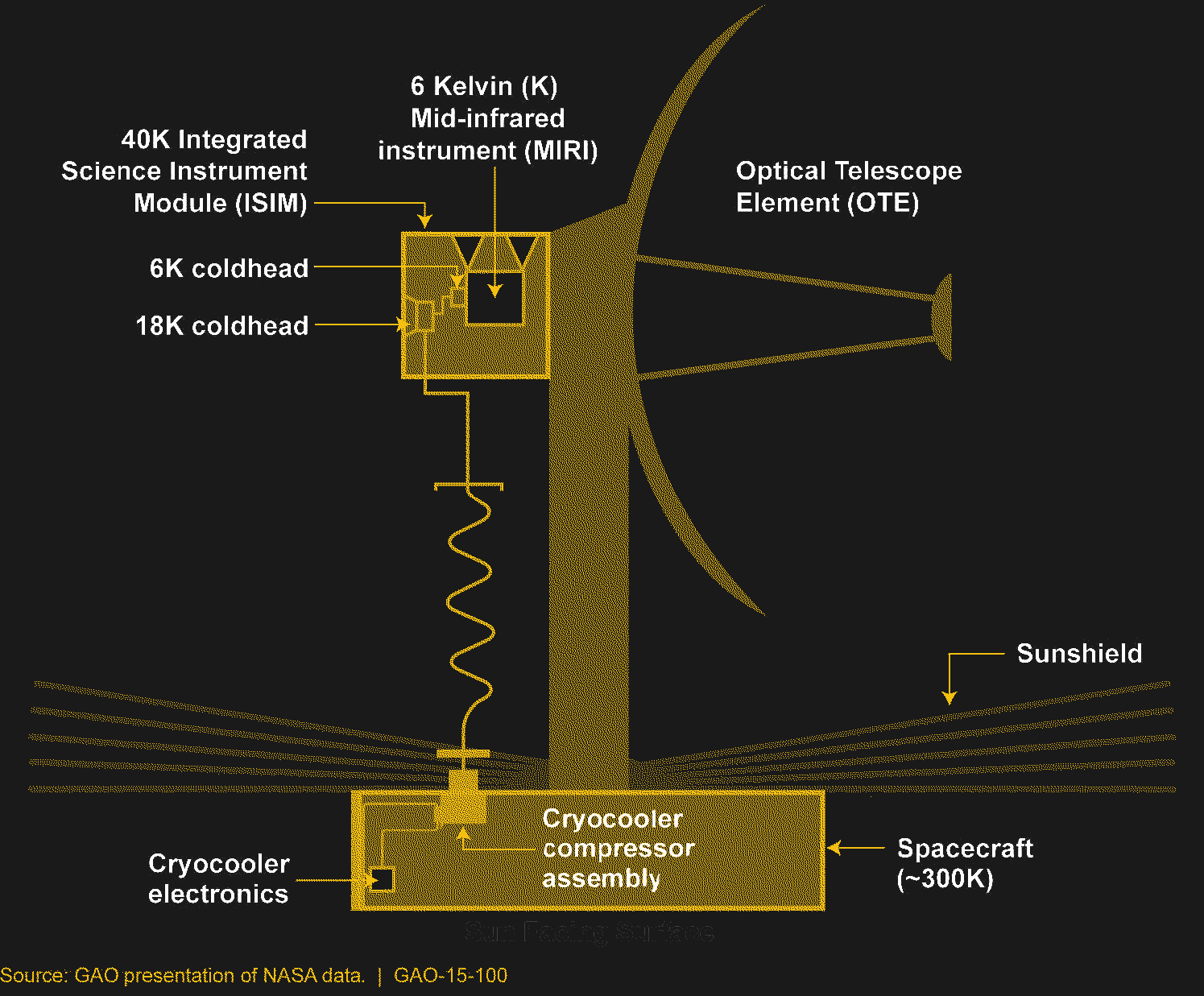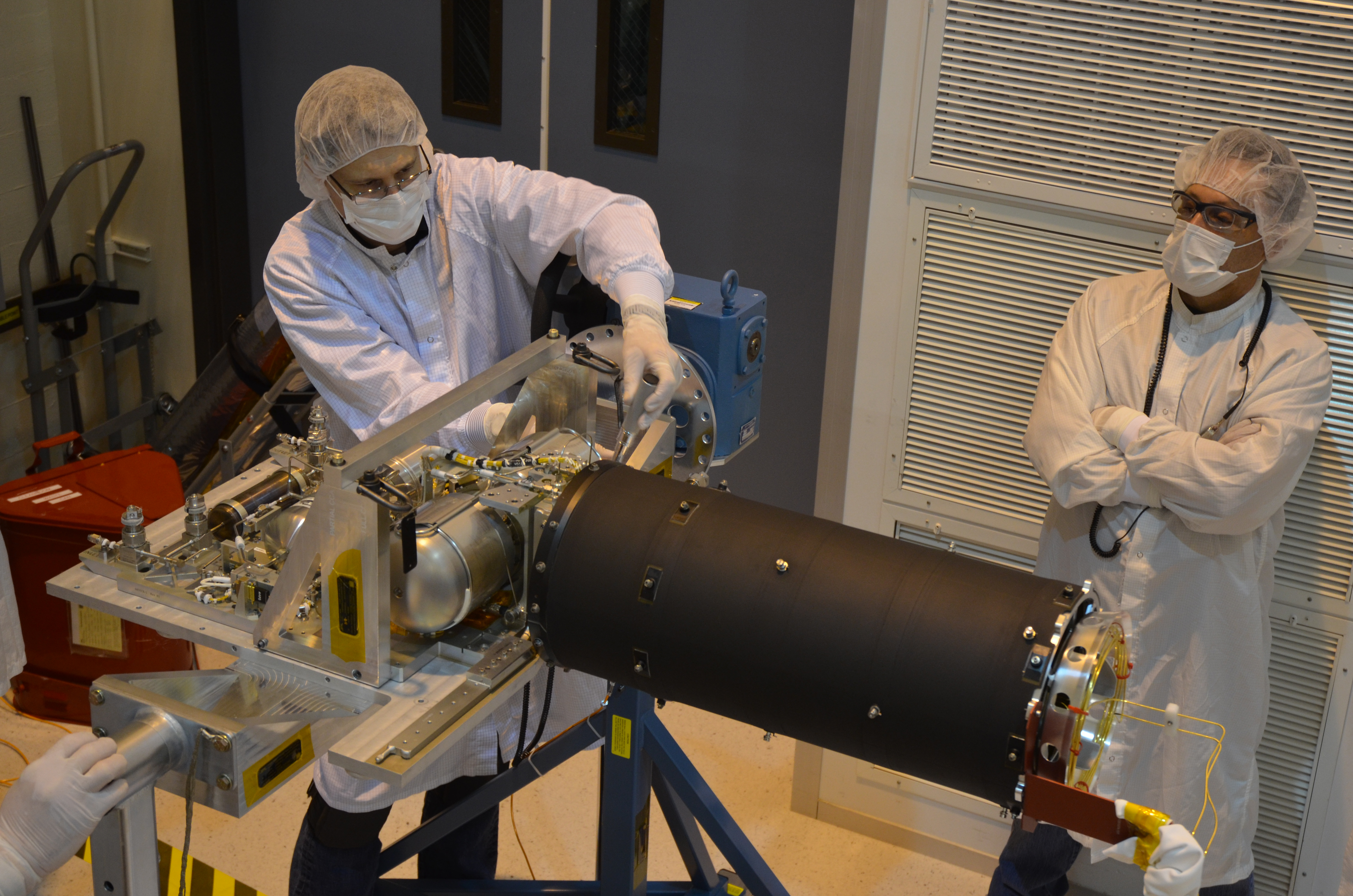If you were asked to name the coldest spot in the solar system, chances are pretty good you’d think it would be somewhere as far as possible from the ultimate source of all the system’s energy — the Sun. It stands to reason that the further away you get from something hot, the more the heat spreads out. And so Pluto, planet or not, might be a good guess for the record low temperature.
But, for as cold as Pluto gets — down to 40 Kelvin — there’s a place that much, much colder than that, and paradoxically, much closer to home. In fact, it’s only about a million miles away, and right now, sitting at a mere 6 Kelvin, the chunk of silicon at the focal plane of one of the main instruments aboard the James Webb Space telescope makes the surface of Pluto look downright balmy.
The depth of cold on Webb is all the more amazing given that mere meters away, the temperature is a sizzling 324 K (123 F, 51 C). The hows and whys of Webb’s cooling systems are chock full of interesting engineering tidbits and worth an in-depth look as the world’s newest space telescope gears up for observations.
Not Cold Enough
Probably the first most obvious question regarding cryocoolers in space is: Why in the world does Webb even need a cryocooler? Isn’t space, especially the area around Webb’s halo orbit around Lagrange point L2, already cold enough? In a word, no — the infrared astronomy Webb’s instruments are designed for, space is nowhere near cold enough. But what’s so special about infrared astronomy, and why does it require such low temperatures?
From its earliest designs, what would become the James Webb Space Telescope was always conceived as an infrared telescope. This is because the objects Webb was intended to study are among the oldest objects in the universe, and Hubble’s Law tells us that the farther away an object is, the faster it is moving away from Earth, the light from them will be dramatically red-shifted thanks to the Doppler effect. This means that the light from pretty much everything Webb will be pointed at lies somewhere in the infrared part of the spectrum. Webb’s four imaging and spectrographic instrument packages can cover from the very edge of the visible portion of the spectrum, around 0.6 μm wavelength, to the mid-infrared wavelengths around 28 μm. For reference, microwaves start at about 100 μm wavelengths, so the frequency of the light that Webb is designed to study isn’t that far above the radio part of the electromagnetic spectrum.
The problem with infrared astronomy is that the sensors used to pick up the light are easily overwhelmed by the heat of their surroundings, which radiates in the infrared region. Also, the photosensors used in infrared telescopes are susceptible to dark current, which is a current flow in the sensor even in the absence of any light falling on it. Dark current is primarily caused by the thermal stimulation of electrons within the sensor material, so keeping the sensor as cold as possible goes a long way to reducing noise.
There’s Cold, and Then There’s MIRI Cold
As stated earlier, Webb has four main instruments. Three of them — the Near-Infrared Camera (NEARCam), the Near-Infrared Spectrograph (NEARSpec), and the Fine Guidance Sensor and Near-Infrared Imager and Slitless Spectrograph (FGS-NIRISS) — all operate in the near-infrared part of the spectrum, as their names suggest. The near-infrared is just below the visible part of the spectrum, around 0.6 to 5.0 μm. The sensors for these wavelengths use an alloy of mercury, cadmium, and tellurium (Hg:Cd:Te), and require cooling down to around 70 Kelvin to be usable.

For Earth-based near-IR telescopes, cooling Hg:Cd:Te sensors is usually done with liquid nitrogen. On Webb, though, another option is available, thanks to the massive, five-layer sunshade that protects the observatory from the blazing light of the Sun, as well as the light reflected off the Earth, which thanks to the telescope’s halo orbit is always in view. The layers of Webb’s aluminized Kapton sunshade are spaced out such that incident IR bounces between adjacent layers and eventually radiates out into space more or less perpendicular to the sunshade, rather than penetrating through the layers to the sensitive optics on its dark side. The sunshade receives on the order of 200 kW of energy on the hot side, while allowing only 23 mW to pass through to the cold side. This keeps the instruments located there are a frigid 40 K, which is plenty cold enough for the three near-IR instruments.
But as cold as 40 Kelvins above absolute zero may be, it’s still far too hot for the sensors in the fourth of Webb’s primary instruments. The Mid-Infrared Imager, or MIRI, is designed to take images and make spectrographic observations from 5 to 28 μm, which requires an entirely different sensor than its near-IR cousins. Rather than Hg:Cd:Te, MIRI’s sensor is based on arsenic-doped silicon (Si:As), which needs to be cooled to very close to absolute zero — less than 7 Kelvin.
Sounds Pretty Cold
In the original Webb designs, the ultra-cold temperature needed for MIRI was going to be provided by a Dewar flask containing a cryogenic substance: solid hydrogen. The choice for a stored cryogenic system was made based on the immaturity of space-rated active cryocooling systems capable of reaching 6 K at the time. However, Webb’s now-infamous delays allowed cryocooler technology to develop, and in light of the weight savings an active cryocooler offered, not to mention the potential to use MIRI longer — the instrument would be useless once the solid hydrogen had all boiled off — the decision was made to replace the cryogenic Dewar.
This wasn’t without engineering challenges, of course. Chief among these were the ability to hit the target temperature while staying within power and weight constraints, and not adding undue mechanical vibration to the sensitive optics. Both of these specifications were particularly challenging given the sheer size of Webb, and the physical layout of the observatory, which made it necessary to spread the cryocooler assemblies over three different areas of the spacecraft, each with different thermal regimes to deal with.

The warmest region, designated Region 3, is located in the spacecraft bus. It’s on the hot side of the sunshield, which means it can expect to see temperatures up to 300 K or so. The assembly that’s mounted in this region consists mainly of the cryocooler compressor assembly (CCA) and its associated control electronics. The CCA is the “precooler” of the whole system, using a three-stage pulse tube design to achieve temperatures of about 18 K. Pulse tube cryocoolers have no moving parts aside from the pistons used to generate the pressure waves, making them excellent for low-vibration applications like this.
The pulse tube refrigeration process relies on thermoacoustics to transfer heat. In thermoacoustics, a standing wave is set up within a working gas (helium in the case of Webb’s cryocooler) within a sealed tube. A porous plug, called a regenerator or recuperator, sits within the tube, close to one of the nodes of the standing wave. As the working gas is compressed and expanded, a temperature gradient sets up across the regenerator. The hot end of the pulse tube radiates heat out into space via a heatsink, while the cold end is used to remove heat from a closed-loop heat exchanger, also charged with helium. The video below has an excellent demonstration of the principle of thermoacoustic cooling.
The cooled helium, now at around 18 K, enters Zone 2, which is within the tower that supports Webb’s primary mirror. The temperature in this region is between 100 K and almost 300 K, and the supercold helium has to pass through about two meters of tubing to reach the instruments at the telescope’s focus, so a great deal of engineering went into making sure there would be no unwanted heat transfer.
At the end of its trip through Zone 2, the refrigerant reaches the heart of Zone 1 — the focal plane of MIRI itself. This zone is already at about 40 K thanks to the passive cooling steps outlined before, but to drive the refrigerant down to its final 6 K temperature, it passes through what’s known as a Joule-Thomson valve. The JT valve makes use of the Joule-Thompson Effect to cool the helium working fluid even further.

Joule-Thomson says that when the pressure of a gas is reduced, its temperature is also reduced. It’s something we’ve all seen before, as when frost forms on the outside of a dusting air can, or the cloud of water droplets that form when an air cannon lobs a projectile into the air. In Webb’s Cold Head Assembly (CHA) inside MIRI, a special valve allows the pressure of the supercold helium to drop suddenly, causing it to drop to around 6 K and cooling a copper block upon which the MIRI sensors are mounted. The helium is piped back through the JT valve and back down the tubing to the CCA, in a closed-loop system.
So far, Webb’s cryocooler system is hitting all its marks and keeping MIRI happy. As of this writing, the temperature at the MIRI focal plane has been steadily holding below the 7 K setpoint for more than 14 days, with the other near-IR instruments holding well below their 40 K target. Here’s hoping that we get to see results from these instruments soon.
And just for the record, the coldest natural spot in the solar system might actually be the “double-shadowed craters” on the Moon’s south pole, at only 25 K. Poor Pluto — never any respect.















The Joule-Thompson effect is also the working principle of terrestrial refrigerators/ACs. Zone 1 is pretty directly analogous to what’s keeping your lunch meats cold, though typically a phase change is involved in the expansion step in your standard fridge.
Okay, time for me to play the pedant:
Technically, the coldest known place in our solar system are in certain research labs where scientists have managed to cool things down to a mere fraction of a Kelvin. The JWST is indeed cold, but not technically the coldest.
Here is a SciShow video talking about them, as well as Cold Atom Laboratory on the ISS:
https://www.youtube.com/watch?v=RQL_5D3ROi4
I will pedant back. These places generate particles at these cold temperatures. According to the video you linked they do it for a maximum of 25 ms. Its not a constant temperature, but particles generated as needed. While jwst is actually a whole chunk of visible matter constantly at that temp. I’d say that counts more towards coldest place.
I fully agree with DrainBummage.
Making such a long and pompous introduction for something that is not even true is just silly.
Helium boils at 4.15K and plenty of that stuff is used all over the place.
https://en.wikipedia.org/wiki/Liquid_helium
The Universe is also a big place. It’s so big we can’t even see the other end
And yes, there are also plenty of “places” further away.
“Our” sun and the mudballs surrounding it are much less than a ppm of “our” galaxy , and that is an even tynier fraction of the Universe.
So all the introduction does is convey a gross ignorance of what’s out there.
I once had a discussion with one of my “teachers”. He wanted to know what was the most important part of a car, and I told him is was a stupid question because lots of parts of cars are important enough that the car won’t work without it. I guess I was about 10 years old back then, and I didn’t like school much.
The Solar System doesn’t contain the whole universe bro.
Oops,
I guess I got distracted by the “coldest place in the Univese” video posted later.
The answer the teacher was looking for is ‘tires’.
It’s a question of how gracefully the car will degrade if the part failed and how important they are to control and stopping. Going is secondary.
As for going, ask any racer. Tires are the most important.
Your teacher wasn’t wrong.
On topic. Shouldn’t a Bose-Einstein condensate be the ‘coldest place’ by definition? They make those all the time.
IIRC they were going to throw them at something, perhaps the nerdy physicist. Like an inkjet.
Excuse: Old SciAm in Excrameditation chamber, so I’ve read 20 year old news many times.
The IBM Quantum computers go to about 20 millikelvin, which is considerably colder.
Yeah. The James Webb is awesome for many reasons, but it is far from the coldest place in the solar system. In grad school I ran a few dilution fridges, and those got down to 0.006 to 0.010 kelvin using a commercially available, off the shelf system. 6k is burning hot compared to that!
The magnets of the LHC are kept at 1.9K
To play the actual pedant: Read the post again? Dan never said that Pluto, or the JWST, was the coldest anything. He mentioned Pluto b/c it certainly isn’t warm there, and as far as orbiting things inside the solar system go, it’s pretty cold.
And I totally agree with his rhetorical device that it’s pretty amazing that the JWST has a hot side and a cold side — with the hot side being like Death Valley in the summer and the cold side being significantly cooler than Pluto. That’s an amazing engineering feat.
But mic-drop pedantry: Dan never said JWST was the coldest. Not in the headline, not in the article.
Benchoff coined a word for the type of comments where people are like “actually, it’s 17” when in truth, it’s 19. That would be an “incorrection”.
What do you call a comment that’s attempting to be pedantic, but is pedanting against something that wasn’t ever said? And what do you call the editor’s response to such? The mind boggles!
Interesting article. Really good video explaining thermo-acoustic cooling. Thanks!
Ironically, one of the hardest things to do in space is keep cool, since there’s no atmosphere to conduct heat away.
Exact! So a good weapon for space wars would be powerful IR cannons… Ships would overheat and forced to move off the battle.
or a small craft to spray something dark onto the target…let the sun do the hard work.
and built it, to a large number of small satellites, preferably with cover story of broadband internet comm..
..wait a minute
its worth mentioning i work in low temperature physics so im relatively qualified to retort…we regularly cool larg masses > 500kg to around 3 kelvin. some very large mri systems ~35 tonne masses are cooled to around the temperature of liquid helium which is about 4.2 kelivin. when you lower the pressure above liquid helium its possible to get to around 1 kelivin/ and using the isotope of
“The depth of cold” only here one can find such absurd wording…
You’ve never been “chilled to the bone”?
B^)
324 K (123 F, 51 C)
Please stop mistreating units. It´s 324°K (123°C, 51°K)
Kelvin are not degrees. 324 kelvin, 123 degrees Fahrenheit, 51 degrees Celsius. But just 324 kelvin.
(Because degree indicates that 0 is not Absolute zero)
> (Because degree indicates that 0 is not Absolute zero)
Thanks rnjacobs. Quoting social media, I was this days old when I learned why Kelvin has no degree symbol and is not referred using words such as xxx degrees Kelvin.
You’ve out-pendanted the pedant! (And I completely agree with you. :)
Small detail, Pulse-tube Coolers are not using thermoacoustics. They use cyclic compression and expansion of helium, comparable to the Stirling cycle. The wavelength in helium at the typical frequencies these Coolers work at is a few meters. Much longer than typical dimensions of such a cooler. They use the temperature variation in the bulk of the working gas (because of the pressure oscillations), while thermoacoustic coolers are based on the interaction in the thermal boundary layer at the fluid/solid wall (surface heat pumping)
Microcalorimeters are some of the best energy dispersive X-ray spectrometers we have, they have been put on satellites and are routinely kept around 100 times colder than the 7K sensor on the James Webb.
So yeah, opening with more of a nerd snipe than a hook.
Far-infrared telescopes have to run colder ~0.3K. Herschel did it with liquid He-3 (unfortunately only had 5 year life span). Ground based far-ir/sub-mm instruments also run fractions of a kelvin (e.g. SCUBA-2, NIKA2, MUSCAT)